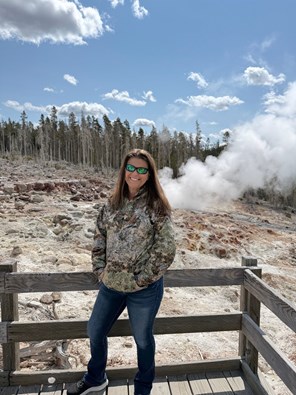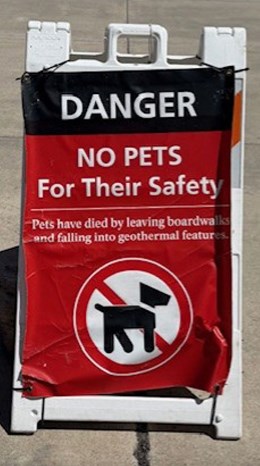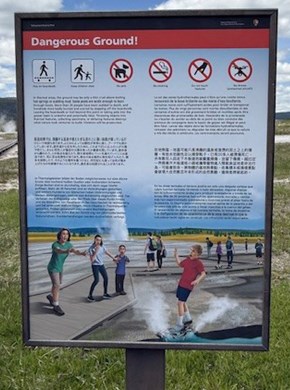Staying Safe in National Parks
Tags:
America’s national parks are treasures to be enjoyed by all. However, be sure to follow all the rules to ensure a safe—and legal—outing!
Americans are once again hitting the roads for their annual summer vacations, which may include destinations within the National Park System. But each year many visitors to federal lands end up injured or worse because they fail to follow basic rules that include carrying firearms, wildlife viewing, hydrothermal features, and preparedness. Staying safe while visiting these national treasures should be your No. 1 priority. Here’s how to comply:

Carrying Firearms
There are several reasons for carrying firearms in national parks and they all are for the safety of you and your family. After several high-profile crimes against women in national parks, President George W. Bush signed into law the right of every American to carry firearms on federal lands (this constitutional right was guaranteed by the CREDIT CARD ACCOUNTABILITY RESPONSIBILITY AND DISCLOSURE ACT OF 2009, TITLE V MISCELLANEOUS PROVISIONS, Sec. 512: Protecting Americans from violent crime.) These include National Park Service (NPS), Wildlife Management Areas (WMAs), and Bureau of Land Management (BLM) properties.
Even though it is legal to carry your firearm on federal lands, it is important to know the laws when doing so. This can be confusing because laws pertaining to the carrying of firearms on federal lands can vary from state to state. If you decide to cross state lines and visit one or more federal lands this summer, make sure you are following the laws of each state you are traveling through.
The laws pertaining to carrying a firearm on federal lands are that you must follow the laws of that state. For example, if you are on federal lands in states such as Texas or other western states, no permit is required to open carry or conceal carry your firearm. If you are on federal lands in many northeastern states, you must have a permit and are only allowed to conceal carry. This can become confusing with the different firearm reciprocity laws such as full reciprocity, no reciprocity, and unilateral reciprocity agreements.
It is important to remember that regardless of the state in which you reside, as of now, you cannot carry in any federal buildings. I reiterate “as of now” because this is currently being challenged throughout the courts. It is also important to know what constitutes a federal building where you cannot carry your firearm inside. The rule regarding carrying in a federal building is one where employees are normally present. For example, a visitors center or a gift shop would be buildings where you could not carry your firearm inside, but a stand-alone restroom that is not inside a building would be permissible.
Wildlife Viewing
As the name implies, wildlife is “wild.” Wildlife found in national parks are not tame and should be treated with respect. They are dangerous and have the potential to cause serious injury or death. Every year numerous individuals are injured by getting too close to wildlife!
Never approach or feed wildlife to lure them closer to you. Many injuries and deaths are reported each year when visitors are trying to capture the “best” photo and intrude an animal’s space. For example, in Yellowstone National Park, one must stay at least 100 yards away (the equivalent of five school buses) from bears and wolves. Similarly, one must stay at least 25 yards away (the equivalent of two school buses) from all other animals including bison, elk, moose, deer, sheep, etc. These rules are in place to protect not only wildlife but also the safety of the people.
Most animals are active at dawn and dusk. If you remain quiet and listen, you will often hear wildlife before you see them. Always carry binoculars and/or a spotting scope to scan the horizon and observe wildlife from afar. Be mindful of your surroundings. If you are focused on animals in front of you, frequently check the areas around and behind you, in case other animals may approach or change their behavior due to your presence. Always carry bear spray as a personal defense in case you startle a bear, especially a sow with her cub(s), and she begins to charge you. Know the areas where dangerous animals such as black bears or grizzly bears frequent and be alert when you are along a trail or just pulling off the road to take photos.

Hydrothermal Features
Some national properties have hydrothermal features. Yellowstone National Park has the most hydrothermal features and is one of the most visited national parks annually. It is oftentimes referred to as “The Restless Giant,” and is home to the world’s largest group of hydrothermal features. Massive volcanic eruptions occurred at this location; the latest about 631,000 years ago. The center of this “supervolcano” collapsed and is now where the majority of Yellowstone National Park is located. This formed a 30 x 45-mile caldera, or basin, and the heat powering those eruptions still fuels the park’s hot springs, geysers, fumaroles and mudpots.Whenever you are in an area with hydrothermal features, it is extremely important to follow the rules like always staying on the designated trails or boardwalks for your safety and to protect the fragile geological formations. Secure hats and other items that can blow away in the wind and land in one of these features. Never throw anything into a feature, since coins, sticks, or other items can easily choke off water circulation and destroy thermal activity. Never touch the water. Temperatures and acidity levels can be high enough to dissolve flesh from bone. The ground around many hydrothermal features is very unstable and can be paper-thin. This means that you could easily fall through the ground into very hot and acidic water.

Pets are not allowed in these hydrothermal areas. The first reported death in these areas was when a dog jumped into a thermal pool and the owner jumped in after; neither were recovered. Several years ago, a brother and sister wandered off a trail to explore the Norris Geyser Basin in Yellowstone National Park. Unfortunately, the brother fell through the ground into extremely hot and acidic water and his body was never recovered.
Preparedness
Anytime you plan an adventure, always be prepared and know your personal limitations. If you are not normally an “active” person, now is probably not the best time to venture on a 10-mile mountainside hike. If you have bad knees, it may be difficult to sit cross-legged for hours in a raft or on a paddleboard on the water. Recognize your personal limitations and remember them on your outdoor journeys.
Keep an ice chest in your vehicle with food, snacks, and plenty of water. Even if water is not your preferred choice of drink, it is what your body needs the most of, when out in Mother Nature. If you are going on a day hike or plan on spending time in the backcountry, keep enough water, a filtration straw, or water purification tablets with you to stay hydrated.
Always carry a day pack to include snacks and water, and a First Aid kit in case of minor cuts, burns, or stings, or other outdoor injuries such as sprains or breaks. If you are lost or traveled further than originally planned and cannot get back to your vehicle or base camp before dark, you will be glad you had your pack!

If your expedition takes you to higher elevations than to which you are accustomed, it is very easy to dehydrate and succumb to altitude sickness if you do not prepare yourself ahead of time. If you are in the same location for several days, slowly acclimate to your environment. Take some small hikes before you plan to tackle a big one. Higher elevations mean closer proximity to the sun. Always apply plenty of sunscreen with high SPF protection, wear a hat, long pants and a long-sleeved shirt to protect your skin from dangerous rays.
Weather and temperatures can change in a matter of minutes when outdoors. Always have a change of clothes with you and dress in layers. As the temps warm up it is easy to remove layers to remain comfortable and add those layers back when the temperatures plummet. Plan for the worst and anticipate the best! Knowing and accepting your limitations will allow for a much better experience and a safe return home.
Summer is supposed to be fun, and our National Park System is a great place to start. It is important to know the rules to stay safe. Mother Nature can be very dangerous but at the same time be the most remarkable thing to witness. Unless you have ever been completely surrounded by the forces of nature, you cannot appreciate the wonders of our world!
